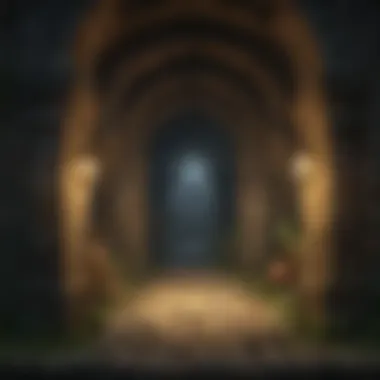Exploring the Sound Effects of the Zelda Series


Intro
The soundscape of The Legend of Zelda series is not just an auditory experience; it's a vital element that enhances both gameplay and storytelling. The way sound effects intertwine with various elements of the game creates a rich tapestry that can often go unnoticed by casual players, yet it plays a crucial role in setting the tone and atmosphere of the game.
From the heart-thumping pulse when a dramatic event unfolds to the joyful chime when collecting items, the sound effects in Zelda games are meticulously crafted to evoke emotions and guide players through their adventures. Essentially, the aural dimension can elevate the gaming experience from mere escapism to a deeply immersive journey, where players feel like they truly inhabit the world of Hyrule.
In this exploration, we will dissect the significance of sound effects throughout the Zelda franchise. We will touch on various gameplay elements, narrative contexts, and even the cultural influences behind these soundscapes. The aim is to shine a light on how these auditory cues serve as storytelling devices, enhancing player engagement and emotional connection.
Game Reviews
When assessing the overall gaming experience of the Zelda series, one cannot ignore the impact of sound design. While the visuals dazzle the eye, sound effects ensnare the ears and tie together gameplay mechanics with thematic elements.
Gameplay Features and Mechanics
Every action within the game prompts a unique sound, signifying outcomes ranging from success to failure. For instance, the triumphant jingle that accompanies unlocking a chest serves as an auditory reward for exploration. Each sound effect reinforces the action taken by players,
- The swish of a sword during a battle,
- The rhythmic click of a puzzle solution,
- The sinister noise of a lurking enemy.
These sounds build a cohesive experience that ensures players feel connected to their actions. Special attention is given to the timing and impact of these sounds to maintain an engaging gameplay flow.
Storyline and Quests
The melody of Link’s journey often takes distinct turns corresponding with the narrative arc. Consider the haunting sounds that accompany the darker themes, or the uplifting music when players achieve major quests. For example, the eerie whispers in the Wind Waker when exploring forsaken islands carry with them a sense of mystery that enhances storytelling.
Visuals and Sound Design
Visuals may present the setting, but it’s the sound that transports players. The delicate, ambient sounds of nature in Breath of the Wild create a serene environment, allowing players to feel as if they are truly wandering the vast landscapes of Hyrule. Moreover, the juxtaposition of music and sound effects during battle scenes captures the intensity perfectly. Each step taken on different terrain, from gravel crunching to water splashing, adds depth to the experience.
Sound is not just background noise; it is an integral part of the emotional landscape of the game.
Comparison with Previous Titles
As the series has evolved, the sound effects have undergone significant transformation. The early games relied heavily on 8-bit sound, while newer titles, notably Breath of the Wild, incorporate intricate layers of audio elements, from intelligent ambient soundscapes to rich musical scores. This evolution not only reflects advances in technology but also an understanding of how crucial sound is to player experience and immersion.
Character Analyses
Characters in the Zelda universe each possess unique sounds that denote their personality traits and emotional states. From the cheerful melodies of Navi to the deeply melancholic tunes associated with Princess Zelda during pivotal moments, sound serves to reflect character development and contribute to storytelling.
Popular Characters Overview
- Link: Often associated with heroic and adventurous sounds, strengthening his identity as the protagonist.
- Zelda: Her themes often include layers of grace and sorrow, highlighting her complexity as a character.
- Ganon: His imposing presence is underscored by dark and oppressive sounds that create feelings of dread.
Character Development and Backstories
Sound effects can also echo the journey of characters. For instance, as Link’s abilities grow, the sounds associated with his actions change, reflecting his development.
Role in the Zelda Universe
While gameplay mechanics can force encounters or exploration paths, it's the auditory cues that often define characters’ impacts within the story. Sounds link players emotionally to their journeys and transformations.
Fan Theories and Speculations
Intriguingly, fans have connected certain sounds to broader narrative theories, including the motivations and alignments of characters based on their soundscapes. This speculative interplay between sound, narrative, and player interpretation enrichens community discourse surrounding the games.
Lore Discussions
The intricate sound design also serves the lore of Zelda, often carrying hidden meanings through its musical motifs.
Mythology and Worldbuilding
Audio cues can reflect Hyrule’s rich history and mythology. The sound of the Master Sword, for example, evokes deep-rooted traditions and fables within the universe—a subtle nod to its legacy.
Legendary Items and Artifacts
Each notable item often comes with its own distinctive sound, anchoring its importance and role within the story. The Ocarina of Time, known for its enchanting melodies, does not just play music; it invokes change in the game world itself.
Link to Real-world Mythologies
Many sounds in the game resonate with folklore from various cultures, reinforcing the interconnectedness of stories across different eras and societies.
Timeline Placement and Theories


Fans have debated how sound influences the timeline placement of certain titles, suggesting that specific audio cues create continuity, enhancing the sense of a larger narrative.
Gameplay Strategies
Finally, the sound landscape can often provide vital information for gameplay strategies, helping players navigate through challenges and puzzles.
Combat Techniques and Tips
The sounds of combat not only set the stage for fights but also provide feedback for successful hits or dodges, guiding strategic moves.
Puzzle Solutions and Walkthroughs
Auditory clues often hint towards solutions in puzzles. Observing audio patterns can unveil secrets and hidden paths, facilitating progress through the intricate game world.
Collectibles and Side Quest Guides
Listening carefully can alert players to nearby treasures, adding an intriguing layer of exploration to the gameplay.
Boss Battles Tactics and Strategies
The aural indicators during boss fights are critical; they intensify the engagement while signaling player actions, creating a syncopated dance of sound and strategy.
Through our analysis, we see the profound impact sound effects have on the Zelda gaming experience, shaping not just how we interact with the game, but how we understand its deeper narratives. These carefully curated sounds establish a foundation that drives emotional connections and immerses players within the captivating world of Hyrule.
Prelims to Sound in Gaming
In the realm of video games, sound is often the unsung hero. It quietly weaves through the tapestry of gameplay, enhancing the experience in ways that players might overlook at first. In this article, we aim to explore this intricate aspect of game design, especially within the beloved Zelda franchise. The role of sound is not just decorative; it’s fundamentally intertwined with how players interact with the game world.
From providing crucial feedback during combat to establishing a mood that can transport players to a far-off land, sound effects serve numerous functions. They guide players, indicating whether their actions are successful or not, while also enriching the storytelling experience. Imagine wandering through Hyrule without the melodic chimes that signify discovery or the ominous notes that herald an enemy’s approach. It’s these sound cues that help to create a rich, immersive environment.
The Role of Sound Effects
Sound effects in games like Zelda do more than just please the ear; they can elevate a moment from mundane to memorable. For instance, the satisfying ping of collecting rupees not only marks progress but also feeds into the psychological reward system. The brain recognizes this sound as an indicator of achievement, which reinforces the player’s actions and encourages further exploration.
Moreover, sound effects establish immediate context. A player knows that a door is locked, for example, when they hear the distinct thud of a barrier. This auditory cue eliminates the need for extensive tutorials or on-screen prompts, allowing players to naturally engage with the environment. Such interactions create a fluid experience where players can lose themselves in the richness of the game world.
Historical Context of Zelda Sound Design
When we look back at the historical context of sound design in the Zelda series, there’s a fascinating evolution from simple chiptunes to orchestral compositions that would make any maestro proud. The original The Legend of Zelda, released in 1986, utilized the limited sound capabilities of the Nintendo Entertainment System. It produced iconic 8-bit melodies that are forever engrained in the minds of fans. Despite these limitations, Koji Kondo and his team crafted memorable tunes that remain beloved to this day.
As the series progressed, so too did the technology behind sound design. The leap to Ocarina of Time marked a significant shift, where audio became more complex, utilizing full orchestration. This not only enriched gameplay but further immersed players in the fantastical world of Hyrule. The tracks were no longer just accompaniment; they became an integral narrative device, guiding players through emotional peaks and valleys.
In summary, sound is a foundational element that contributes immensely to gameplay experience and storytelling in the Zelda series. By understanding the role of sound effects and their historical context, we can gain a deeper appreciation for the layers of design that elevate the franchise to its revered status.
The Evolution of Sound Effects in Zelda
The journey of sound in the Zelda franchise is nothing short of remarkable. From modest beeps and bloops of early systems to sweeping orchestrations that fill the air with emotion, this evolution encompasses not just a technical advancement but also a profound transformation in how players experience the game. The sound effects are integral to gameplay; they affect how players interact with the world around them and with other characters. This section delves into two pivotal aspects of that evolution: the transition from simple melodies to rich scores and the technological advancements that made such innovations possible.
From 8-Bit to Orchestral Scores
When you think back to the earlier days of Zelda, specifically The Legend of Zelda and Zelda II: The Adventure of Link, the audio landscape was dominated by 8-bit sounds. They were catchy enough to remember and super effective for the era, but let's be honest—they were also, well, somewhat limited. The sound effects here often served practical purposes like indicating item collection or signaling combat events. The simplicity of the audio, while endearing, forced artists to be creative with composition—every note counted.
Fast forward to Ocarina of Time, and the tone shifts dramatically. The introduction of orchestrated music marked a high point in video game sound design. The orchestral scores breathe a new life into the experience and serve the narrative in ways that the earlier titles could only dream of. You can really feel the weight of the moment when Link plays the iconic Zelda's Lullaby, with strings swirling around you. The evolution was a game changer; it turned auditory elements into a narrative device, shaping how players engaged emotionally with the game.
Technological Advancements and Their Impact
Technology has played a monumental role in shaping the soundscape of Zelda. Early sound chips, like the ones in the Nintendo Entertainment System (NES) and Super Nintendo Entertainment System (SNES), were limited in capability. These devices had to work wonders with minimal resources, and they did—a testament to the creativity of the sound designers. However, once technology caught up, the possibilities exploded.
With the advent of CD-ROMs and advanced sound modules, titles like The Legend of Zelda: The Wind Waker enhanced player experience through a more sophisticated sound design. No longer confined to simple synthesized tunes, developers could layer sounds and create a more immersive environment. This technology wasn’t just an improvement in audio quality; it fundamentally changed how sound could be used.
The use of real instruments tied to emotional cues represents a significant leap in conveying the deep lore and rich world of Hyrule.
In Breath of the Wild, environmental sound effects became a standout feature, showcasing how advanced sound engineering could create a living world. Whether it’s the rustle of grass or the distant roar of a Lynel, each sound adds layers to the narrative. In the age of the Nintendo Switch, sound design has not only been about enhancing graphics but also elevating gameplay through responsive, contextual audio cues.
As we move forward, the emphasis on sound's dynamism and its interaction with gameplay is likely to shape future Zelda installments in exciting ways. The evolution of sound effects has taken us from simple functionality to a rich tapestry of emotional resonance. This venture is not just an appreciation of what was; it is an acknowledgment of how sound design can continually transform storytelling in games.
Iconic Sound Effects from Major Titles
The realm of gaming sound design is rich and varied, but few franchises wield it as effectively as The Legend of Zelda. Iconic sound effects from major titles not only serve functional purposes but also enhance the emotional experience of players. These elements are indispensable in establishing connections between the player and the intricate worlds crafted by the franchise.
As players journey through Hyrule and beyond, each auditory cue becomes a part of the unique language the game speaks. Whether it’s the twinkling sound signaling that an item has been obtained or the ominous tones indicating an approaching battle, these sounds accomplish far more than just notifying the player. They become cherished memories, replayed in the mind long after the console is turned off.


Elements like melody, rhythm, and spatial audio converge to create a captivating auditory story. Captivating sounds connect the player with the environment — blaring horns might suggest danger, while serene melodies evoke tranquility. These sounds can influence gameplay and decision-making processes. Let’s dive deeper into some of the most standout soundscapes from notable Zelda titles.
The Legend of Zelda: Ocarina of Time
In "Ocarina of Time", sound is woven into the very fabric of gameplay. The sound of playing the Ocarina itself stands out, as it is not merely a tool for activating events; it’s a character in its own right. Each melody corresponds to significant actions, such as opening up shortcuts or influencing the in-game time of day. The various ocarina tunes, like the Song of Time or Zelda's Lullaby, resonate deeply with players, furthering immersion through both nostalgia and strategic function.
On a deeper level, the incorporation of environmental sounds is crucial. Venturing into Kokiri Forest, one can hear the soft rustle of leaves and the chirping of fairies, transporting players into a vibrant, living world. Enemies also have distinct attack sounds, allowing players to anticipate movements and create strategy. This nuanced approach to sound effectively reinforces emotional stakes in gameplay.
Breath of the Wild and Ambient Soundscapes
"Breath of the Wild" takes a different approach by emphasizing ambient soundscapes over structured musical compositions. The whispers of the wind across vast plains, the crunch of grass underfoot, and the distant call of wildlife contribute to a feeling of vastness that both comforts and isolates the player. This environmental audio is not just background noise; it subtly guides exploration and interaction with the world.
Most noteworthy is the sound design in relation to weather changes. The distinct rumble of thunder or the pitter-patter of rain serves as more than just atmospheric tasks. They herald challenges and evoke a sense of urgency during battles or stealth sequences. Such intentional audio elements become integral to the experience, creating an immersive world that feels alive and responsive.
Wind Waker's Unique Audio Experience
In contrast, "Wind Waker" employs a more cartoonish sound design that emphasizes humor and lighthearted adventure. The famous ``sailing theme``` is instantly recognizable, inviting players to explore the vast ocean between islands. Unlike previous titles, the game embraces a fluidity to character actions that is mirrored in its sound—every swing of Link's sword has a satisfying swish, while enemy encounters yield comical sounds that undercut tension.
Moreover, Tetra's playful taunts and the Hyrule Castle fanfare bring a lively atmosphere to the otherwise whimsical tone. The subtle layering of different sounds, from the ocean waves crashing against the boat to the background chatter of seagulls, contributes to a sense of continuity. This sound design is unorthodox, but it roots players in the game’s light demeanor while still delivering powerful emotional beats during critical story moments.
The sound effects across all major titles in the Legend of Zelda series not only enhance the gameplay experience but also etch themselves in the minds of players, creating lasting emotional resonance.
In sum, these iconic sound effects are a robust pillar upon which the immersive experience of the Zelda franchise stands tall, shaping memories and enriching the narrative. Each title has its own distinctive notes, harmonizing gameplay mechanics with artistic expression.
Analyzing Specific Sound Effects
Sound effects in video games, particularly in the Zelda series, don’t merely enhance ambiance; they play a pivotal role in player engagement and interaction with the game world. In this section, we delve into specific categories of sound effects that are integral to the player experience. Whether it’s the rewarding jingle after collecting a treasured item or the urgent clang of swords during combat, these auditory cues shape gameplay and narrate unsaid stories.
Item Collection Sounds
When a player picks up an item in a Zelda game, it often triggers a specific sound— a familiar chime or melody. These sounds are designed to evoke feelings of satisfaction and achievement. This isn’t an accident; rather, it’s a calculated design choice made to reinforce positive player behavior. The knack of using musical cues to signify progress fosters a deeper connection to the gameplay; players remember the thrill of acquisition and feel motivated to continue exploring.
For instance, in The Legend of Zelda: Ocarina of Time, the sound of obtaining a new item is both melodic and brief, making it distinct yet not overwhelming. Here’s how it can affect players:
- Psychological Reward: The sound taps into a brain's reward center, creating a mini rush.
- Memorable Moments: Players recall those moments vividly through their associated sounds.
- Feedback Mechanism: Instant auditory feedback helps players recognize accomplishments quickly.
Combat and Enemy Sounds
Combat sounds in Zelda are integral to action experience. They convey crucial information about the flow of a fight as well as the environment. Each sword clashing sound during battles or enemy roars creates an atmosphere of urgency and adrenaline.
Some noteworthy observations about these sounds include:
- Dynamic Response: As players engage in combat, the sounds adjust in intensity, mirroring the escalation of tension in the gameplay. For every encounter with a new enemy type, players can often tell how formidable the foe is simply by listening.
- Distinct Characteristics: Different enemies come with specific sounds, which help in identifying them even before they are visible. This can guide strategy, as players prepare to face particular foes.
- Contextual Awareness: Ambient sounds of battles—for instance, the echoing cries in dungeons or boss arenas—create an immersive experience that keeps players on edge.
Environmental Audio Cues
Amidst the lush landscapes of Hyrule, environmental sounds contribute to the overall feel of the game. Whether it's the rustling leaves, flowing water, or distant bird calls, these cues add depth and realism to the gaming landscape. They are vital, not just for ambiance, but for signaling important interactions.
Key elements include:
- Locational Awareness: Players often rely on subtle audio hints to navigate their surroundings, such as hearing a waterfall to locate a hidden path.
- Mood Setting: The sounds adapt based on the biome; tranquil melodies in a serene forest shift to more ominous tones in dark caves, changing the player's emotional experience.
- Behavior Indicators: Sounds like wind rustling or the faint clang of metal can forewarn of events—like impending enemy presence or secrets lying nearby.
"Sound effects in games are not just fillers; they are the silent storytellers that guide players through every step of their journey."
To sum up, analyzing specific sound effects in the Zelda series reveals their fundamental role in crafting an engaging gaming experience. Each category of sound—item collection, combat, or environmental cues—serves to mesmerize players, making each adventure not just a visual journey but an aural one as well.
Sound Design and Game Mechanics
Sound design serves as a pillar of game development, especially in a series as beloved as Zelda. When one thinks about the interplay between sound design and game mechanics, the connection becomes immediately clear. Sound effects not only embellish gameplay but also shape player perception and interaction with the game world. The auditory landscape offers more than just background noise; it is integral, often guiding players through hints and cues.
Feedback and Player Response
Feedback is vital to how players understand their impact within the game. In Zelda, every chime, every swoosh, every grunt of an enemy contributes to this feedback loop. For instance, the distinctive sound when Link collects an item serves as both a reward and an indicator of progress. The auditory cue reinforces the player's success, providing a sense of achievement that complements the visuals.
Moreover, the merging of visuals with sound creates a synchronous experience. Take the iconic sound heard when a chest opens. It’s not merely a sound; it’s an invitation that draws players deeper into the world of Hyrule. As players navigate challenges, these audio cues help them respond quickly, enhancing overall gameplay.
Listening to how the sounds interact with actions allows players to strategize better. A loud clang during combat or a gentle rustle when stealthily approaching an enemy provides necessary information that can shift the tide of an encounter.
The Psychological Impact of Sound Effects
The importance of sound effects extends into the psychological realm as well. Sound can evoke feelings and memories, stirring emotions that enhance the immersive experience. Zelda is rich with atmospheric sounds—from the tranquil rustling of leaves in the Lost Woods to the eerie echoes of a dark dungeon. Each of these sounds does more than just fill silence; they create a mood.


Players often find themselves enveloped by the soundscapes, the subtle variations pulling them deeper into gameplay. The ambient sounds can evoke nostalgia, drawing on a player’s personal experiences with the series. The correct notes or sequences can make the heart race or bring a sense of calm. This emotional engagement paves the way for memorable experiences, making the player feel genuinely part of the story.
Lastly, by incorporating recognizable musical motifs linked to characters or themes, the game uses sound to solidify identity and context. The heros journey through Hyrule becomes not just visually captivating but sonically profound. As players engage with both the game and each other, they share stories of their adventures, often punctuated with the incredibly impactful sounds that fueled them along the way.
In essence, sound design in Zelda does not simply complement gameplay; it molds it. These carefully crafted audio elements are not just effects; they are the very heartbeat of the series, resonating long after the game is turned off.
Cultural Influences on Zelda Sound Design
Sound design in the Zelda franchise is not just about creating appealing audio for players; it also serves as a rich tapestry woven from various cultural influences. These influences enhance the gameplay experience and help to form a deeper connection with the narrative and characters. By examining cultural references in sound design, we can grasp how they contribute to building the atmospheric worlds that define the series.
An essential element of sound in Zelda is how traditional music elements have been embedded into the soundtrack. This incorporation reflects the game developers’ dedication to authenticity and provides players with a sense of familiarity. It is important to recognize that the music doesn't just exist as a backdrop; it actively shapes player emotions and enhances storytelling.
Incorporating Traditional Music Elements
When players traverse the vast landscapes of Hyrule, they are often greeted by melodies that seem to echo ancient traditions. Traditional instruments, like flutes and lutes, are utilized to create a sound that resonates with a time long past. For example, the use of the ocarina in Ocarina of Time itself serves as a nod to wind instruments found in numerous cultures around the world. The soothing sounds draw players in, creating a sense of nostalgia that feels almost tangible.
In the Breath of the Wild soundtrack, the gentle strumming of a guitar or the soft notes from a harp play a crucial role in immersing players in their surroundings. Sounds are not just musical notes; they are reflections of cultures that may span continents. Drawing inspiration from various civilizations encourages players to see the game world in a broader context.
Here are some ways traditional music elements uplift the gaming experience:
- Authenticity: Using cultural instruments lends credence to the fantasy world, making it feel more genuine.
- Emotion: Each note evokes feelings that align with the narrative, enhancing the emotional weight of certain scenes.
- Connection: Familiar sounds invite players to forge their own cultural connections, making them feel linked not only to the game but also to the diverse cultures from which the sounds emanate.
Referencing Mythology and Folklore through Sound
The auditory aspects of the Zelda series are also laden with references to mythology and folklore, which underscore the game’s narrative richness. Sound effects often parallel story elements rooted in legends, bringing an extra layer of meaning to the gameplay.
One telling example is the music themes associated with specific characters. Link’s iconic theme has a distinct sound then can remind players of heroic tales found in global mythologies. Such musical motifs help to establish a connection between Link and mythical heroes, encouraging players to view him as a character out of an epic tale.
Additionally, the use of rhythmic patterns and tonal choices mirrors the storytelling techniques found in age-old folklore. For instance, ambient sounds resonating during certain quests can feel reminiscent of folk tales being recounted around a campfire, instilling players with a sense of adventure and exploration.
"The music in Zelda is a bridge connecting gameplay to rich cultural narratives, inviting players to explore not just a fantasy world but their own understanding of myth and folklore."
In summary, the cultural influences in sound design are pivotal. They bridge the game world with player experiences and broader human narratives. As we continue to explore Zelda's acoustic landscape, it becomes evident that its sound design is a profound reflection of the world's collective heritage.
Future Directions in Zelda Sound Design
As the gaming industry presses forward, the Legend of Zelda series stands at a crossroad, brimming with potential for sound design that could significantly shape player experience. The future of sound effects in this beloved franchise is not merely about enhancing audio quality, but also about engaging players on a deeper emotional level. Understanding where sound design could head in the next installments provides valuable insight into the evolution of game mechanics, storytelling, and player immersion.
Potential Innovations and Experiments
When it comes to innovation, Zelda has always had an eye for integrating new technologies. One potential area to explore is adaptive soundscapes, which adjust in real-time based on player actions and decisions. Imagine wandering through the lush fields of Hyrule, and as Link makes different choices—like deciding to engage an enemy or opt for stealth—the sound environment morphs to reflect that choice.
Another avenue is the incorporation of 3D audio technology, where sounds can be positioned in three-dimensional space. This would not only enhance immersion but also aid in gameplay by providing critical audio cues, giving players the feel of true spatial awareness. Let's consider how we can use sound to tell stories that have a temporal progression, focused on the emotional resonance tied to character arcs through melodies associated with moments of joy, danger, or resolve. Additionally, implementing collaborative sound experiences could also be intriguing. In cooperative multiplayer modes, each player could contribute to a shared audio landscape that changes based on collective actions.
Overall, the opportunity lies in blending traditional Zelda melodies with contemporary sounds, creating a sonic bridge between generations.
Listener Engagement in Future Titles
The success of a game lies significantly in how it engages its audience. Next-gen Zelda titles must embrace listener engagement strategies that heighten the player’s connection to sound. This involves not only using familiar themes but also encouraging player contribution. For instance, introducing mechanics like a 'sound crafting' system where players can create their own tunes to solve puzzles could make gameplay even more interactive.
To bolster player engagement, it's crucial to leverage community feedback. Incorporating sounds based on player suggestions or remixing themes from the community into the actual gameplay creates a shared ownership over the sound landscape of Zelda.
Moreover, future Zelda titles could further delve into immersive audio storytelling. This could be done via linear narratives woven seamlessly into gameplay, where background music dynamically adapts to reflect a character's emotions or the intensity of a situation—a musical narrative fever dream of sorts, enhancing the storytelling depth.
"Engagement isn't just about what players hear; it's invoking feelings that stick with them long after the game is off."
Ultimately, as Zelda’s acoustic landscape continues to expand, the possibilities of sound design can serve as a powerful vessel for creativity and player engagement. The journey ahead for sound in Zelda is ripe with opportunity, promising to create memorable experiences that resonate with players of all ages.
End: The Lasting Impact of Sound Effects
In examining the sonic fabric of the Zelda series, it becomes abundantly clear that sound effects are not merely a background element; they are instrumental in crafting the overall gaming experience. These audio cues evoke emotions, set the scene, and often guide the player’s actions, making them an essential part of gameplay and narrative cohesion.
Summary of Key Themes
This article sheds light on several pivotal aspects regarding the sound effects in Zelda:
- Immersion: The rich, layered sounds transport players directly into the world of Hyrule. Whether it’s the clashing steel during combat or the peaceful rustle of leaves in the wind, these effects draw players deeper into the narrative, fostering an engagement that transcends the visual experience.
- Emotional Resonance: Sound impacts how players feel during their journey. A simple sound, like the classic Item Get jingle, can evoke nostalgia and triumph. Conversely, unsettling sounds may invoke fear during a boss encounter, enhancing the stakes.
- Feedback Mechanism: Each sound serves a practical purpose. When players hear a specific sound after defeating an enemy or acquiring a treasure, it reinforces their actions, giving them immediate feedback that can influence future decisions.
- Cultural Significance: Integrating elements of traditional music and folklore enriches the sound landscape. It's a testament to how deep storytelling can blend with auditory art, creating a sense of place and history.
As the gaming landscape evolves, these themes underscore the significance of sound design in Zelda, reinforcing its identity and enhancing the player’s journey far beyond mere gameplay.
The Legacy of Sound in the Zelda Franchise
The sound effects in the Zelda series have left an indelible mark not only on the series itself but on the industry as a whole. From its inception, the use of sound has evolved, yet the essence remains rooted in creating an engaging experience for players. The blend of melodic motifs, ambient sounds, and distinct audio cues has formed a legacy that defines the franchise.
Consider these impactful elements of the legacy:
- Innovative Sound Design: The transition from simple MIDI sounds to full orchestral scores reflects the franchise’s commitment to quality. This evolution has inspired other games to prioritize sound as a core component of their design.
- Cultural Influences: The incorporation of various musical styles from around the world adds texture and authenticity, positioning Zelda as a game that resonates with a global audience.
- Enduring Soundtracks: Iconic compositions, such as those from Ocarina of Time, have permeated popular culture, often being performed in symphonies and covered by musicians worldwide.
As we look to the future, the legacy of sound in the Zelda franchise will undoubtedly continue to shape game design while thrilling players and building deeper connections within its narratives. The meticulous crafting of sound effects not only enhances gameplay but also carves out a unique auditory identity that cements the Zelda series in the pantheon of video game history.







